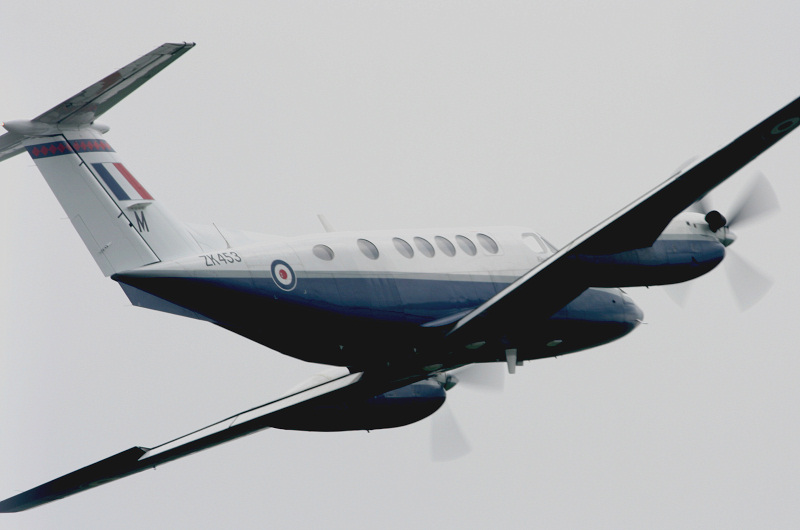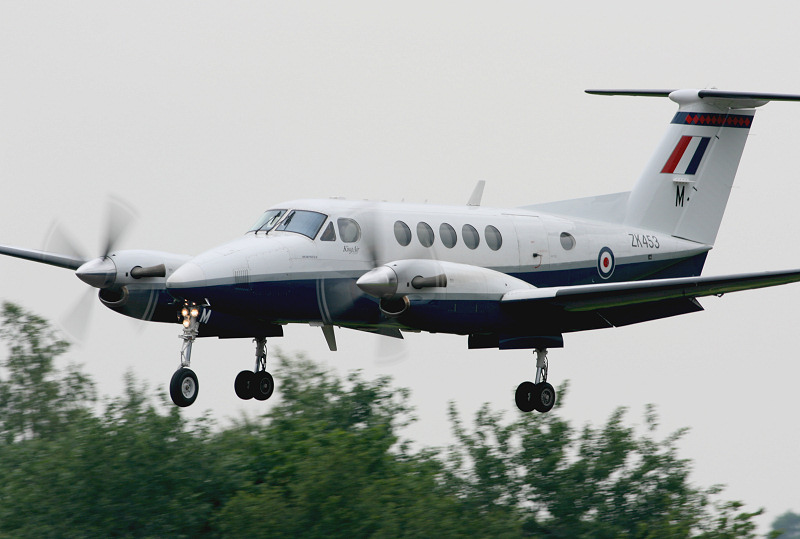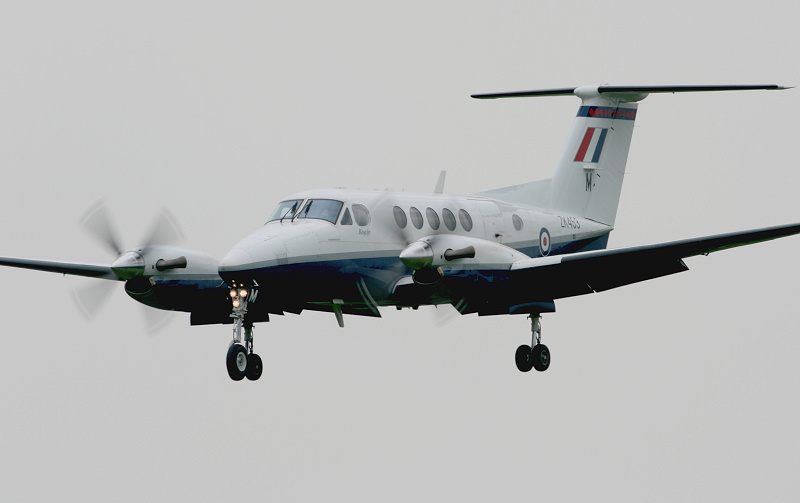|
RAF King Air B200
The Beechcraft King Air B200 is a twin-engine turboprop which entered RAF service in 2004. It is used as a multi-engine advanced pilot trainer by No 45(Reserve) Squadron, which is part of No 3 Flying Training School based at RAF Cranwell in Lincolnshire. Prior to flying the King Air, students who have been streamed to fly multi-engine aircraft at the end of elementary flying training undertake survival training and personal development training to prepare them for the rigours of operational service. They then join No 45(R) Squadron where they complete an additional 30 hours training on the multi-engine lead-in (MELIN) course, flying Firefly M260 aircraft. During the MELIN course, students are taught crew co-operation and procedural flying skills to prepare them for their advanced flying training on the King Air.
King Air students learn essential multi-engine techniques such as general handling, asymmetric flying, emergency handling and radio-aids navigation, and consolidate the multi-crew skills acquired on the MELIN course. As the course progresses, the emphasis shifts towards developing captaincy, crew resource management, and managing the King Air's advanced avionics systems. Students also learn advanced skills such as formation flying, low-level flying and airways navigation, and are expected to plan and manage composite missions involving several aircraft. On completion of the course students are awarded their coveted pilot's wings, and then undertake conversion to their frontline aircraft type at an Operational Conversion Unit. A variety of shorter King Air courses is available, with students' previous flying experience determining which course they undertake; this experience can be as little as 100 hours for a student arriving straight from elementary flying training, to several thousand hours for a qualified pilot transferring to the multi-engine role from fast jets or helicopters.
The King Air has performed extremely well throughout its first five years in RAF service, and has proved popular with students and instructors alike. In addition to its flying training role, the King Air can be used to carry up to 6 passengers or freight. Its combination of a well-proven airframe with advanced cockpit and systems make it an ideal training platform for the new generation of multi-engine aircraft entering RAF service. In 2008, the fleet of seven King Air B200s was augmented by two B200GTs which feature improved high level cruising performance and a fully electronic 'glass cockpit'. These can be identified by the red line on their fuselage side.

RAF King Air B200 at RAF Cosford 2008.
KING AIR B200 FULL DISPLAY SEQUENCE
Minimum met conditions: Full Display 5km/2000ft
Limited Display 5km/1300ft
Flat Display 5km/1000ft
| Ser | Event |
| 1. | Max performance short-field take-off from L to R* |
| 2. | Level acceleration at 100 ft MSD |
| 3. | Break L 45° |
| 4. | Wingover R through 260° onto display line |
| 5. | Parabolic knife-edge pass |
| 6. | Climbing turn R through 260° on 45° axis towards datum |
| 7. | Steep descent |
| 8. | Steep turn L through 465° |
| 9. | Wingover L to intercept 90° axis |
| 10. | Wingover L through 135 ° if landing in same direction as take-off. Otherwise, this and all subsequent manoeuvres are reversed. |
| 11. | Reverse turn to align with runway |
| 12. | Fly past 240 kts (300 ft MSD) |
| 13. | Break L through 30°, pitch up 30° then climbing turn R to align with runway |
| 14. | Steep approach (30° pitch down) |
| 15. | Land then max reverse to achieve stop just past datum |
| 16. | Demonstrate reverse taxying, then vacate |
* Direction chosen to simplify sequence description; display can be flown in either direction.
The display can be flattened as necessary to remain sufficiently clear of cloud: wingovers become flattened and Ser 5 may be replaced by banked pass.
The display lasts approximately 7 minutes from brakes-off to vacating the runway.
The ELO song Mr Blue Sky complements the display very well. It lasts 5 minutes and fades nicely to give sufficient time at the end to describe the steep approach. We commence the display by switching on landing/taxy lights on the nosewheel leg, so be ready to hit play as the lights come on!
Frequently Asked Questions
How fast does it go?
The King Air B200 has a maximum speed of 259 knots or Mach 0.52. One 'knot' is 'one nautical mile per hour', and since a nautical mile is 1.15 statute miles, 259 knots is equivalent to 298 mph. On take-off, at light weight, the King Air B200 accelerates from 0 to 100 mph in about 12 seconds.
How much power?
Each of the Pratt and Whitney PT6A-42 turboprop engines produces 850 horsepower. With a total of 1700 horsepower and a typical display weight of 4.5 tonnes (about 10,000 lbs), the King Air B200's power to weight ratio is 378 horsepower per tonne, which is more than most high performance sports cars.
What is a turboprop?
A turboprop is simply a jet engine driving a propeller. The jet engines in the King Air are mounted back to front: air enters the intake underneath the propeller and is routed under the engine before being turned up through 180 degrees to enter the engine compressor. The propeller is not mechanically connected to the engine but has a 2 stage turbine of its own that is spun by high speed air exiting the engine. The engines rotate at up to 38,000 rpm and the propeller spins at up to 2000 rpm.
Can the King Air fly on one engine?
Yes. Even at maximum weight, one engine produces enough power to keep the aircraft climbing away from the ground.
Has it got guns?
No!
How far can it go?
Like many transport aircraft, range is a balance of fuel versus load: as passengers are added, the fuel carried must be reduced to keep the aircraft below its maximum take-off weight of 5.66 tonnes (12,500 lbs). In multi-engine pilot training, it is essential that student pilots experience long-range high altitude operations and the complexities of international operating procedures. On a typical overseas training flight, the King Air could fly non-stop from its home base in Lincolnshire to northern Spain, Italy or Austria.
How high can it go?
Although the King Air B200 is cleared to fly at 35,000 ft, our own regulations restrict us to 28,000 ft. The air inside the cabin is pressurized to keep the cabin altitude below 8000 ft.
Why are the leading edges of the wings and tailplane black?
The black areas are inflatable rubber 'boots'. Using air bled from the engines, they are inflated when required to break off ice which can build up when flying in cold damp conditions.
Where do students go when they have completed the King Air course?
Most students progress to become co-pilots on the following types: BAe 125, BAe 146, C17, Hercules, Nimrod, Sentinel, Sentry, Tristar and VC10. Additionally, 45(R) Sqn trains Army pilots destined for the Defender and Islander.
|

RAF King Air B200 at RAF Cosford 2008.
KING AIR DISPLAY PILOTS
The King Air display is flown by Qualified Flying Instructors (QFIs) from 45(Reserve) Squadron based at Royal Air Force Cranwell in Lincolnshire. For the 2009 display season, the aircraft will be flown by Flight Lieutenant Leon Creese.
Flight Lieutenant Leon Creese
Leon was born in Salisbury and raised in Ringwood, Hampshire. After education at Ringwood School and Brockenhurst College he joined the RAF as a direct entrant at the age of 19. After graduating from Initial Officer Training, Leon remained at RAF Cranwell where he completed flying training on the Jet Provost T5. On completion of multi-engine advanced flying training on the Jetstream T1 at RAF Finningley, he commenced the first of two operational tours on the C130K Hercules at RAF Lyneham in support of global operations including Kuwait, the Balkans and Sierra Leone. Following a short ground tour in support of Headquarters Training Group, Leon commenced training as a King Air QFI. Leon is in his fifth year on 45(R) Sqn where he has been responsible for the training and assessment of student pilots and, as a Central Flying School (CFS) Standards Flight instructor, the type conversion and continuation training of qualified flying instructors.

RAF King Air B200 at RAF Cosford 2008.
| |

RAF King Air B200 at RAF Cosford 2008.
|
Leon says...
On safety
My colleague Kiwi, our supervisors at RAF Cranwell and I, have put a good deal of effort into ensuring the display is as safe as it can be while still being entertaining. The absence of a g-meter in the King Air means that our display follows a carefully designed set of parameters and gates that ensure the loads exerted on the airframe are well within its limits. The engines have no self-limiters, meaning that, if I simply pushed the power levers (we don't call them throttles) fully forward for full power, I would overstress the propeller gearboxes; this could cause a catastrophic failure. This is further aggravated by the torque (that's a measure of the engine power being used to drive the propellers) increasing as the speed increases, completely independently of power lever position. This means the engines need close monitoring throughout the display, and Kiwi is responsible for ensuring they remain within limits. He is also responsible for calling out our heights and speeds throughout the display. This enables me to maximize my attention on the ever changing attitude of the aircraft, and our position relative to the display datum (crowd centre) and the display axes, while still being fully aware how close to the limits of the flight envelope we are, and indeed how close to the ground we are.
On g-limits
Although we have no g-meter in King Air, the aeroplane still has g limits: +3.17g with the landing gear and flaps up, reducing to +2g as soon as either is selected down; the negative g limits are -1.27 and 0 respectively, although we maintain a small amount of positive g at all times. While experience helps a pilot judge how much g he is pulling, by keeping to a strict profile of power settings, pitch and bank attitudes, and recovery heights and speeds, we can be confident that we remain well within the published g-limits.
On bank angles
It is widely accepted that the g experienced is relative to the bank angle - the more bank you apply, the more g you feel. This is, in fact, not true. The direct correlation between g and bank angle is only valid under certain flight conditions, most notably when maintaining altitude. It is for this reason that while you may see an aircraft at much more than 60° bank, the g load on that aircraft could be much less than the 2g normally expected for this bank angle.
On simulators
We are lucky to have two King Air simulators at RAF Cranwell that we use to supplement the aircraft for student training. We have made good use of the simulator to develop the display, not only in proving the manoeuvres under normal circumstances, but also in contingency planning for potential failures. At the press of a button, we can simulate any number of failures from a simple blown fuse to a double engine failure. By combining challenging display manoeuvres with major system failures, we can be sure that the risks associated with our display are kept to the absolute minimum.
On the weather
The weather plays a major part in any display. Each aircraft type will have a cloudbase and visibility limit below which it would be unsafe to display. For a full King Air display, we need a cloudbase 2000ft or more above the display area, and at least 5km visibility. If the weather is worse, we can perform a limited display and in the worst case, a flat display with a cloudbase as low as 1000ft. On windy days, I have to make allowance for drift, so each manoeuvre, while apparently simple, could involve several power changes and invisible (to the audience, I hope) changes to our flight path to ensure that at the end of each manoeuvre we are in the right place with the correct amount of energy. Our take-off and landing direction is also determined by the wind. It is normally better to take-off and land into wind; however, the King Air has sufficient acceleration and braking performance that provided the wind is fairly light we can take-off and land in opposite directions. A simple change of direction on the towards-crowd wingover halfway through the display determines at which end of the runway we will commence our steep approach to land.
On steep approaches
The steep approach is one of the most challenging elements of the display to get right. By design, it should always be safe: we enter from the same height, at the same airspeed, in the same configuration, with idle power every time. This means that when we reach our planned recovery height, we always have a known amount of energy. By proving the safety margins at maximum weight, we can be confident that we will always be able to transition from the steep phase to a normal landing within the height available. The difficult part is judging when to commence the descent. Once we start down the slope, there is very little I can do to affect where we touch down: the entire procedure to landing is flown without adding power. If the conditions were always the same, this would be straightforward, but they aren't: the wind can be anything from 60mph on the nose, to over 10mph from behind. I also have to consider stopping distance. If the runway is sufficiently long, I will endeavour to stop just after passing the display datum at crowd centre. With full reverse thrust selected, even with only moderate braking, the King Air stops from 115mph in about a thousand feet. That is unless there is a tailwind, the runway is wet, or it slopes. The stopping distance is also affected by the weight of the aircraft. So in judging when to commence the descent from 1000ft, I have to consider a large number of variables.
On reverse thrust
The King Air is able to reverse the angle of each individual propeller blade such that, instead of scooping air and throwing it backwards - as for normal flight - the blades slap the air forwards causing the aircraft to stop very quickly after landing. By selecting reverse thrust when stationary, the aircraft may be taxied backwards.
Thanks to Flight Lieutenant Leon Creese (King Air Display Pilot)
|
|
